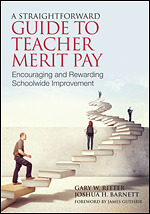A Straightforward Guide to Teacher Merit Pay
Encouraging and Rewarding Schoolwide Improvement
- Gary W. Ritter - University of Arkansas, USA
- Joshua H. Barnett - Arizona State University, USA
Foreword by James Guthrie, National Superintendents Roundtable
Reward your best teachers for the great work they do!
Is your school system considering teacher merit pay? Now is the time to understand the potential benefits and pitfalls of performance-based teacher pay, as well as how today’s most successful programs were developed. Drawing on substantial research with school districts, Gary Ritter and Joshua Barnett provide a step-by-step approach to setting up a merit pay system in your school district. Readers will find
- An overview of existing merit pay programs and their strengths and weaknesses
- A review of the 12 most common myths about merit pay, and how school leaders can respond
- Six guiding principles for designing a merit pay program, along with how-to’s and timelines for every phase
- Guidance on creating balanced assessments based on multiple measures of teacher effectiveness, and developed in collaboration with teachers
Ensure that your district’s merit pay program supports teachers’ professional growth, schoolwide progress, and student achievement.
“Ritter and Barnett bring much-needed researched clarity to this complex issue. For school administrators, education policy makers, legislators, and others interested in school reform, this book is a must-read.”
—Rod Paige, Former U.S. Secretary of Education
“This guide is a useful resource for undertaking merit pay, preventing pitfalls, and most importantly, offering solid recommendations for creating well-designed implementations.”
—Gary Stark, President and CEO
National Institute for Excellence in Teaching
"In place of one-size-fits-all systems of teacher evaluation and compensation, A Straightforward Guide to Teacher Merit Pay helps policymakers and leaders craft systems that value clarity, communication, and collaboration. As researchers who work closely with schools and districts to improve instruction and management, Ritter and Barnett appreciate nuance and address concerns in a thoughtful and fair-minded fashion. This volume will serve as an invaluable resource to school, district, and state leaders seeking to design pay systems that will encourage innovation and reward excellence."
"Performance pay for teaching has increasingly become part of the national education agenda to improve teacher quality and student outcomes. As a result, more and more states, districts, and schools are making performance pay a cornerstone of their strategy to revolutionize the way teachers are trained, supported, evaluated, and compensated. The question is: How can we start schools on the right foot to sustain performance pay over the long term? We know that performance pay systems are more likely to work when teachers are trained on the plan and support it from the outset. This guide is a useful resource for undertaking merit pay, preventing pitfalls, and most importantly, offering solid recommendations for creating well-designed implementations."
"Current teacher compensation systems are inefficiently structured and deficient in attracting America's best graduates to teaching and retaining the best teachers. After years of different approaches and rigorous analyses, we have learned much about the performance pay debate, including what doesn't work. Ritter and Barnett provide a thoughtful and comprehensive examination of this complex topic, cutting through key issues that school leaders must address in order to establish a performance pay plan that has the best chance for success."
"The education reform initiative referred to as teacher merit pay has unleashed a tsunami of controversy throughout the nation. Even as the issue is hotly debated, the complex elements underpinning the value and implementation of an effective model of teacher merit pay is not only little understood, more egregiously, creditable information on the issue has been, until now, limited. Fortunately, Ritter and Barnett's great book brings much needed researched clarity to this complex issue. For school administrators, education policymakers, legislators, and other interested in school reform, it's a must-read."
"A Straightforward Guide to Teacher Merit Pay is a great handbook for anyone wanting to learn about merit pay plans and considering how to get such a process started. It is easy to read and contains lots of examples and ideas based on the experience of the authors."
"A Straightforward Guide to Teacher Merit Pay examines the research and history of merit pay that is quite enlightening to those who may not know so much on the topic, as well as by those who think they know about this topic. The practical recommendations are grounded in common sense and experience. Decision makers will be delighted in the way in which the authors present this topic."
"A Straightforward Guide to Teacher Merit Pay presents a thoughtfully crafted and research based investigation of how merit pay could work in a school system. For policymakers and practitioners alike, the principles for developing a merit plan in this book should reframe the merit pay debate. Moreover, school leaders will resonate with how skillfully the authors have bridged theory with practice to offer a practical guide to proposing and implementing a merit based pay system."
"A Straightforward Guide to Teacher Merit Pay is your one-stop resource for understanding the history, research, and implementation tools for establishing a merit pay program in your school or district."
"As a former middle school principal and school superintendent, I have had 20 years of experience with performance pay in the state of Arizona. I wish I had read this book before embarking on my performance pay journey. The timelines for program development and implementation are exactly the steps I would follow if I were to begin my journey again. Congratulations to the authors for writing such an outstanding text to help the school leaders of the future."
"Gary Ritter and Joshua Barnett give a great overview on merit pay in terms of history and the positive and negative aspects. The authors give the advantages that developing this program can have for a school."
